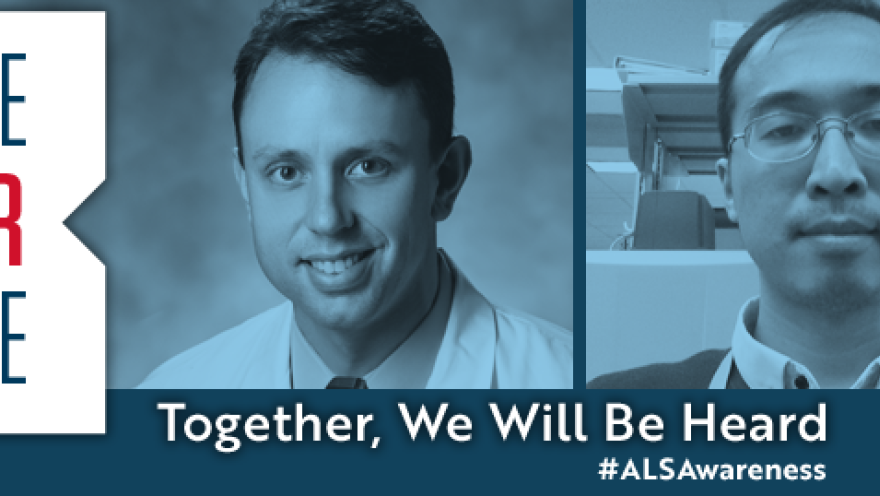Researchers around the world working together for treatments and a cure for ALS are a main reason why we’re on the verge of changing the nature of the disease forever. As part of National ALS Awareness Month, we sat down with two ALS researchers at Johns Hopkins University in Baltimore who are funded by The ALS Association.
Dr. Ke Zhang, a postdoctoral fellow who was awarded a Milton Safenowitz Postdoctoral Fellowship in 2014 and another, Dr. Thomas Lloyd, associate professor of neurology and neuroscience, who we have supported for many years and currently fund.
ALS is a complex disorder with numerous molecular and cellular pathways involved in disease. All the underlying mechanisms of these pathways and how they could potentially connect and interact are still under intense investigation.
Together, with their colleagues, Drs. Zhang and Lloyd recently published an important paper in the prestigious journal Cell that links together two fundamental cellular pathways – nucleocytoplasmic transport and stress granule assembly – in ALS disease, moving them closer than ever to discovering new therapies for ALS.
We are happy to see that you both played major roles in publishing this important work. How did ALS Association donors help move this project forward?
Dr. Zhang: As a former Milton Safenowitz Postdoctoral Fellow, I feel deeply indebted to ALS Association donors for their generosity. The first year of my fellowship supported me to accomplish my first-authored paper in Nature three years ago. That paper has laid the scientific foundation and provided us with the original idea for our current paper. Benefitting from the continuous support from The ALS Association, I was able to perform further research, test my scientific hypothesis, revise my model, and eventually accomplish the current paper.
Dr. Lloyd: ALS Association funding has been essential to this work. They were the first to fund our proposed research to study nucleocytoplasmic transport in ALS, based on very preliminary data in fruit fly models. This funding allowed the pioneering work that we published in the 2015 Nature paper. Subsequently, we have been funded through The ALS Association global research program to further explore the ability to translate this discovery to new therapies for ALS, and this funding was crucial for this current work.
Congratulations on your Cell paper! Briefly describe the most important findings of your paper.
Our paper describes a detailed molecular mechanism by which cellular stress disrupts nucleocytoplasmic transport and found that inhibiting stress granule assembly can be a potential therapeutic approach for C9orf72-mediated ALS. Stress granules are RNA/protein complexes that are dynamic and stress-induced. Dysfunction of stress granules was previously identified to play a critical role in ALS disease pathways.
Briefly describe what nucleocytoplasmic transport is and how it is connected to ALS.
Nucleocytoplasmic transport is the movement of large biomolecules into and out of the cell nucleus. This process is essential for all cells, but we think may be especially important in large, long-lived neurons like motor neurons, the cells that die in ALS. Our research suggests that neurons from ALS patients have a disruption in nucleocytoplasmic transport.
What is the impact of your paper on the ALS field?
Recent studies on the cellular mechanisms of ALS pathogenesis have pointed to two basic processes that are altered early in ALS motor neurons: stress granule assembly and nucleocytoplasmic transport. However, it was unclear whether these two processes are connected or independent. Our paper has elucidated a mechanistic connection between these two processes and thus shown a more integrative view of the disease. Furthermore, our data add to recent work suggesting that targeting stress granule assembly may be a potential therapeutic strategy for ALS.
Why did you decide to join the ALS field over another field of study?
Dr. Zhang: I started my research training in ALS since I was a student in the lab of Hugo Bellen, an expert in neurodegeneration. The devastating facts of this deadly disease shocked me. Working with an ALS clinician from Japan, Hiroshi Tsuda, I learned that basic research is the only way to discover effective therapies. Hiroshi’s love, passion, and endurance deeply impressed me, and I decided to further this research in Dr. Tom Lloyd’s lab at Johns Hopkins. During my postdoc research, I became further motivated by the innovative technologies and the energetic, productive, and collaborative groups led by Drs. Jeff Rothstein and Tom Lloyd. With the societal awareness of ALS and the generous support from donors, I believed I could achieve much towards our final goal to conquer ALS.
Dr. Lloyd: I first became impassioned to study ALS research in 2002 when on the neurology clinical service of Dr. Stan Appel, as a medical student at Baylor College of Medicine. I had just completed my Ph.D. thesis in molecular and cell biology using fruit fly genetics to understand the development of the peripheral nervous system, and in particular, the neuromuscular junction (NMJ), the synaptic connection between nerves and muscles. As a member of the Medical Scientist Training Program, I decided that I could use my expertise in neuromuscular genetics to study the cause of ALS and seek treatments for this devastating neurodegenerative disease. Therefore, I chose to pursue my neurology residency and neuromuscular fellowship at Johns Hopkins University School of Medicine, one of the top neurology residency programs with an outstanding ALS research program. This Johns Hopkins University community is where I learned how collaborative the ALS research community was and how important this was to advance the field.
Paper Citation
Ke Zhang, et al. Stress Granule Assembly Disrupts Nucleocytoplasmic Transport. Cell. Published online April 5, 2018. DOI: https://doi.org/10.1016/j.cell.2018.03.025
This article is not open access.


Join the conversation. Please comment below.